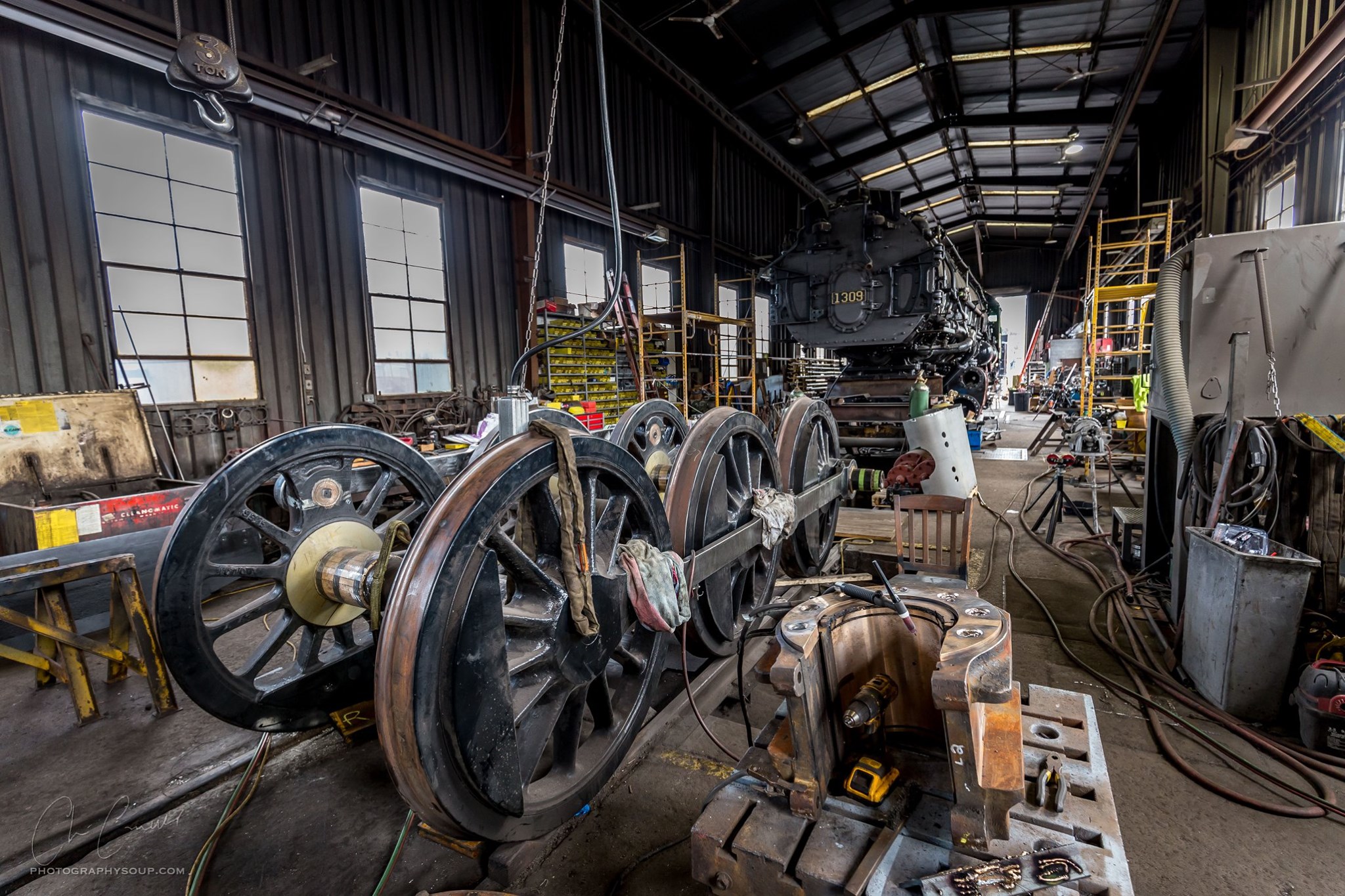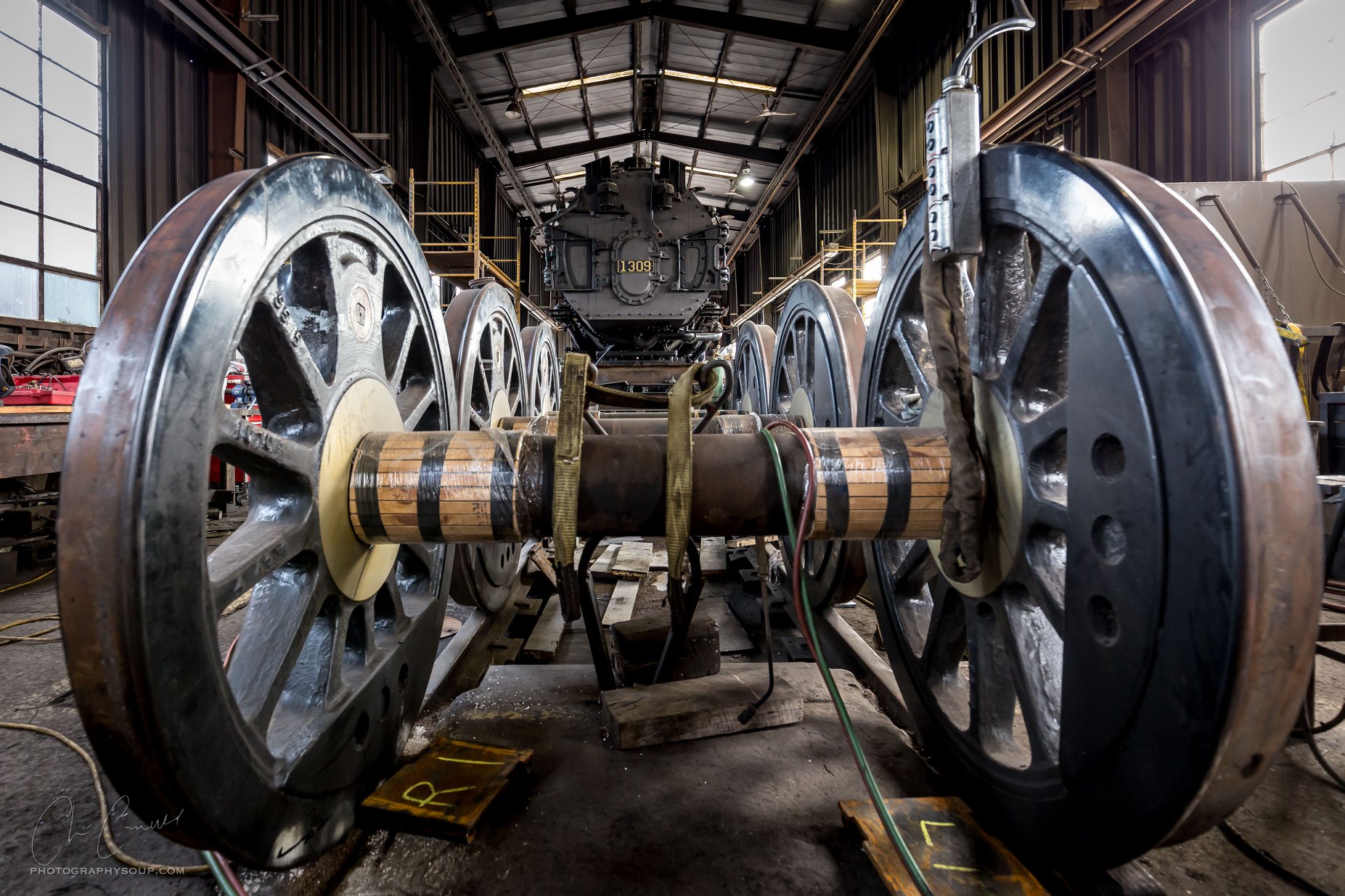Executive Director John Garner gave Trains Newswire today this rundown on work to revive the last steam locomotive made by iconic steam locomotive manufacturer Baldwin in 1949 for domestic use, and when completed, the world’s largest operating compound Mallet:
• Spring rigging on front and rear engines is finished.
• Boring of intercepting and compounding valve is done.
• All shoes and wedges machined and installed in frame.
• Both cross-compound air pumps rebuilt and ready to install.
• Electrical system, including temperature sensors for main bearings, 90% complete.
• Lubrication system 75% complete.
• Driving boxes and hub liners for rear engine complete.
• Front engine boxes and hub liners nearing completion.
Contractor Gary Bensman adds that piston rings from all four cylinders will be replaced with new since the original bronze segments were stolen and scrapped. The valve gear on the high pressure (rear) engine is being completely rebuilt with new pins and bushings.
All the recently machined driving box crown brasses are being hand fitted to ensure proper clearances on the axle bearings.
This is in addition to a completed boiler that has been steamed twice, a backhead, a new cab, and a new tender. But the next big milestone — reuniting the boiler and frame with the driving wheels — is on the horizon once all of the prep work is done.
The crane move to set the engine on its on its two sets of 56-inch diameter wheels was delayed for most of the spring because of parts production problems at machine shops. Bensman says he is working with a crane company, the Belt Group of Cumberland, Md., that is donating its services to set the locomotive on both the front and rear engines on the same day. “It will give us the flexibility needed to get that front engine mated in there properly,” he said in a text message.
Bensman explains the crane procedure that will make the engine whole again: “The rear crane will sling at the front of the throat sheet and will have 85% of the lift. The front crane will sling at the front flue sheet.” The rear of the locomotive weighs much more now than when it was unloaded with the cab, grates, ashpan, and other items installed during the work. Once the boiler and frame are back together, final reassembly can follow.
The $2.7 million restoration has been beset by funding issues, parts theft by an employee, abrupt personnel changes, missed deadlines, and other missteps over the last five years since its acquisition in 2014. But the contractor and the railroad have kept it lurching forward, despite obstacle after obstacle. The locomotive last operated in 1956, and its return to service at Western Maryland Scenic is seen as a potential breakthrough for the tourist railroad that has suffered from a host of issues unrelated to the locomotive, including a problematic landslide area near Frostburg. Restored, No. 1309 will be the only articulated in regular operation in the Eastern U.S., and the world’s largest operating compound Mallet — that is a locomotive that uses its steam twice to drive two sets of cylinders. Its new home is a 17-mile mountain railroad includes the famous Western Maryland Railway location known as Helmstetter’s Curve, and its new Appalachian location is not far from its Chesapeake & Ohio roots in the coalfields of West Virginia.
But right now there is still work to be done, and that’s evident when you talk to the railroad and project managers who have weathered the project’s many ups and downs and are eager to see it finished.
“We won’t announce a completion date or set an inaugural trip until after we have an operating locomotive,” Garner says. “We are eager to get the engine into operation, but we want to do the restoration right, break in the engine, and present it so that it is safe and reliable. That’s our goal, and we’re sticking to it.”
He says that local support is coming from Allegany County and the cities of Cumberland and Frostburg to prepare the tracks for No. 1309. The three entities are providing $90,000 for tie replacement.
Trains magazine gave its $10,000 Preservation Award to the project in 2015, and readers have supported the project with more than $75,000 in donations, which are still being accepted at wmsr.com.
















Holding breath. Turning blue. Can’t wait for a trip to WM to experience another great articulated steam loco in operation. There are other, much larger, much faster, far more powerful locomotives to be sure, but the proportions of this engine and tender are near perfection. This is without a doubt one of the most beautiful locomotives ever built. HUZZAH! to our friends at Scenic Railroad restorations.
Negative commenters have never tried to restore anything. The more you take apart, the more you encounter things that need to be fixed – you can’t find what you need at Home Depot or Lowes – it has the be remanufactured, and the original manufacturer in most cases no longer exists. As the UP showed in the restoration of the 4014 – it will be done when it is done and it will cost what it cost. At least the UP did not have a renegade employee steal critical elements of the locomotive. May that employee rot!
I don’t really care WHERE they got the funding! I sent a bit (very small) to help. I cannot wait for them to get this done, it is finally beginning to look likely to be completed, *knock wood*
2 comments here, 19 on Facebook; Facebook stole my hobby!
Kind of a bad choice of words “break in the engine” and I wonder how many years ago that was developed replacing the words seating the bearings, or fitting the bearings, About as bad as calling a dropped wheel a wreck. But it is very important to flex every spring, spring hanger and seat all the bearing’s Babbitt to steel of the axils.
At a minimum, they’re talking “weeks” to get the crane move done.
2.7 million of which it seems Maryland taxpayers are on the hook for about 2.5+ million, maybe they should paint the tender in the state flag colors and call it the “peoples” engine, lol.
One wonders about the effect on say, the East Broad Top if it had access to WMSR-type taxpayer funding and municipal/local gov’t largesse.